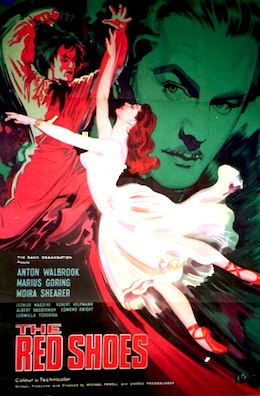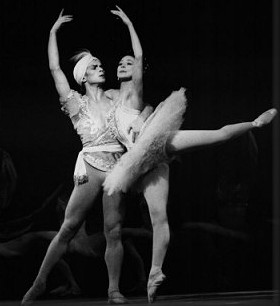In the past, I have written about ballet documentaries, a thriving genre of which there are many fine examples. But sometimes, one is in the mood for the escapism of narrative fiction. When you look for lists of top ballet films, very few of them are fiction; somehow, the two art forms seem to exercise a kind of anti-magnetism on one another.
However, I recently rewatched The
Turning Point, which is absolutely the best ballet movie ever. Ordinarily,
Shirley MacClaine is not one of my favorite actors, but in this film she is
absolutely brilliant as DeeDee, the early-middle-aged ex-ballerina who gave up
her career to raise a family in Oklahoma City with her husband, also former dancer
(played innocuously by Tom Skerritt). Her wistfulness, which I usually
find so annoying, is perfect; beguiled by the might-have-beens, she nonetheless
manages to keep a household running and provide some reasonable parenting to
her three kids. The main plotline has to do with her return to New York to
supervise the apprenticeship at the (thinly disguised) NYCB of her eldest
daughter, played by the ethereal (then) up-and-coming NYCB star Leslie Browne
and her relationship with her former bestie, who is still a principal dancer, played
by Anne Bancroft, with brittle but human grace. More than the plot, though, the
setting is what makes the film – I get such a distinctive sense of a New York
before Disneyfication and Giuliani made it a “safe” place for tourists, and the
developing independence of Emilia (Browne) is so touchingly limned. Of course,
the very best part of the whole film is the transcendent scene where Emilia and
the predictably named Russian principal, Yuri (none other than a very young and
very beautiful Misha), rehearse that wrenchingly erotic pas-de-deux from Romeo and Juliet which then segues into
a love scene back in Yuri’s apartment. I mean, WOW, if you ever thought ballet
was stiff and formal, or that it glosses over sex, um, watch this. And then add
a chaser of Ingmar Bergman’s Summer
Interlude, from 1951, in which Maj-Britt Nilsson plays an older ballerina
reminiscing about a youthful love affair with the usual smouldering,
Scandinavian angst one expects from the great I.B.
 |
| Ballet is hard (Summer Interlude) |
Most ballet movies in the narrative fiction genre leave me
pretty flat. Center Stage, which
often gets cited as “the best ballet movie ever” by people who obviously haven’t
seen The Turning Point seemed to me
just a jazzed up version of something you might see on Nickelodeon; teen
striving, teen angst, some catty byplay, a sympathetic gay black guy... give me
Dance Academy any day for character
development. In the same category of teen melodrama we might place Save the Last Dance (Julia Stiles,
racial tension, ballet vs. hip-hop); and Flashdance,
which is a bit grittier (just as the eighties were grittier than the nineties),
but basically the same story – girl wants to dance, girl is told she can’t
dance, girl dances anyway, and in the end she is a star and gets the guy. What
a feeling!
 |
| Really? |
On the darker side, Black Swan, though it had its moments as
a psychological thriller, was a horror show as a ballet film; talk about
perpetuating the worst stereotypes about dancers and the world of dance while
exploiting cheap, vulgar-Freudian thrills in order to revel in the
victimization and self-destruction of yet another innocent, virginal young
thing. Also, there was this weird lack
of actual dance. File Dancers, the
1987 film with a similar plotline (dancers' lives parallel the plot of the
ballet they’re preparing, only this time it’s Giselle… starring Misha and Julie Kent, so some real dance) under
the same heading of “trite and exploitative.” Oddly, it’s by the same director
as The Turning Point, but the film
poster pretty much captures the cheese factor: Why does Baryshnikov look like an aged Luke
Skywalker here? Why?
Basically, both these films are remakes of The Red Shoes, in which life imitates
art and the ballerina does some kind of fatal (swan) dive at the end, ala Anna Karenina.
As much as I despise the boringness and
antifeminism of this plot, at least The
Red Shoes was great, even innovative filmmaking in its time; the color
(which has been restored) is lush, and the acting is hammy (it’s 1948 for
heaven’s sake) but also pretty lush. Moira Shearer is really lush (that red
hair!). And lushest of all are the extended scenes of original choreography for
the ballet within the film; who can resist all that mid-century modern
goofiness? Plus, the people who made the film were by and large pretty
well-versed in the ballet of the time… notice Leonide Massine there in the
cast.
 |
| Vavoom! |
 |
| Cinema verite. |
Robert Altman’s The
Company made a strong effort to portray the real psychological drama that
goes on offstage, and it also had more dancing of better quality than any of
the “demise of the dancer” psychodramas.
I love Altman – his McCabe and
Mrs. Miller is an all-time favorite of mine and also goes a long way to
explain Warren Beatty’s status as a sex-symbol in the 1970s. The Company was made as a close
collaboration between the Joffrey and Mr. Altman, and has a documentary feel to
it. Even so, in its fidelity to life it is actually a bit messy and dull,
despite a carefully understated performance by Neve Campbell as the heroine, a
young ballerina on the cusp of big success, pondering what this means for her
life. Similarly true-to-life in its content but less artistically sophisticated
is Mao’s Last Dancer, a bio-pic about
Li Cunxin, the Chinese-born and –trained principal for the Houston Ballet and
then Australian Ballet. It has some good dance footage, but by and large the acting
is a bit uninspired.
Then there is White
Nights, which I haven’t seen in years, so I cannot really critique it
except to say that the dance scenes are of course so fun to watch on YouTube (not
that that’s a regular, late night occurrence with me). Really, both Gregory
Hines and “I am in every movie made about classical ballet between 1970 and
1990” Baryshnikov are not at the top of their games anymore at that point, but
it doesn’t matter, because that’s sort of like saying that by 1985 Kareem Abdul-Jabbar
was no longer at peak performance… true, but he was also MVP of the NBA finals
that year, which the Lakers won. Now I’m really showing my age. Ouch. Anyway I
sort of recall that the dynamic between Hines and Baryshnikov essentially
playing themselves was way more interesting than anything else that happens in
what is essentially a late-Cold-War stock narrative with a little racial
tension, a dash of Helen Mirren, a jigger of Isabella Rossellini, and a
top-forty hit by Lionel Richie just to liven things up a bit (say you, say me, say it together… that’s the
way it should be). Without spoiling the film for those of you who haven’t
seen it, let’s just say that it ends with everything “the way it should be” from
a 1985 Hollywood perspective. And what perspective is that, you might ask?
Well, among the top grossing films that year: Rambo First Blood Part II, Back
to the Future, Rocky IV, A View To a Kill, Pale Rider. U.S.A! U.S.A!
 |
| He can jump. |
 |
| So can he. |
One film that is not about
ballet but that has a ballerina as one of its main characters is the
not-so-spectacular sci-fi thriller, Adjustment
Bureau (2011), in which Emily Blunt plays a member of the Cedar Lake Ballet
involved romantically with a politician played by Matt Damon. In that film, the
fact that she’s a dancer is treated as pretty much equivalent to the fact that
he is a politician – both have demanding careers that involve certain
sacrifices on the personal front, and that require seriousness and a fairly
exclusive focus. I think more films in which ballet dancers are portrayed not
as swan princesses, cuckoos, or fainting maidens, but as serious artists who
are also real people might be nice.
Speaking of princesses, one might expect there
to be lots of ballet movies for the younger set, but there really aren’t. The
horridly adorable Emma Watson aka Hermione Granger starred in an adaptation of Ballet Shoes by Noel Streatfeild
(written in 1936); the novel, for children, is of that dotty but delightful and
sneakily serious strain of British children’s literature. But it’s not really
about ballet – it’s about children in the theater business in 1930s London. Meanwhile,
Angelina Ballerina is a dancing mouse who made the grand jeté from books to
animated films, and when my daughter was much younger I am pretty sure we had a
movie starring none other than Barbie that purported to be a version of Swan Lake. Maybe there are others that I
just cannot remember or haven’t seen? Anyway, slim pickins.
 |
| Anna Pavlova, 1912 |
It seems strange to me that the vast junior fiction universe
of ballet stories have not been translated onto the screen. A quick check of
GoodReads reveals an almost limitless virtual bookshelf of ballet-themed books
for young and old. Eva Ibbotson’s critically-applauded YA novel set in 1912, A Company of Swans, about the rebellious
daughter of a Cambridge classics professor who joins a touring Russian ballet company
that takes her to Manaus, where naturally she falls in love and all sorts of
drama ensues, now that would make a good BBC historical drama. I’ve heard
Julian Fellowes is leaving the helm of Downton
Abbey, so why not take this one on?
Sadly, I come to the conclusion that narrative fiction films
about ballet generally tend to disappoint. They get too maudlin about the
psychology of the artists, or they take too much pleasure in the spectacle of
the ballerina’s disintegration, or they merely drape ballet over a plot that
could just as easily serve tennis or motorsport. Often, they don’t bother to
show much real ballet. Of course, there are technical reasons for this; ballet
is difficult to film well: ballet dancers are not Hollywood stars (generally)
who can draw audiences to the theater to see a film: you can’t fake it when it
comes to portraying a ballerina (sorry, Natalie Portman, you are luminious, but
not a ballerina): ballet films are not going to appeal to the biggest
money-making audience sector, which is male and aged 14-25 or something about
like that. Also, it’s hard to imagine how you could turn a ballet film into a
violent digital game.
 |
| But who would play Dame M? |
Still, I just want to throw this one out there. I would like
to beg Gillian Armstrong (the Australian auteur responsible for such films as Oscar and Lucinda and Mrs. Soffel, both must-sees) to pick up
Colum McCann’s
Dancer (see link on right) and cast Daniil Simkin in the Nureyev role. Now,
that would be a ballet movie worth its salt (and salty it would be).
No comments:
Post a Comment